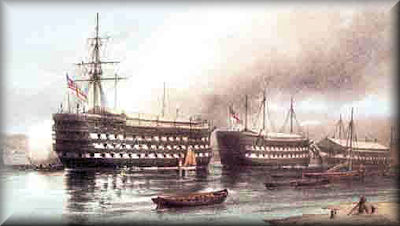‘Schoolies’: Teachers of the Royal Navy and Royal Marines
1700-1914

The picture shows Excellent, Calcutta and Vernon in Fountain Lake,
between Portsmouth Dockyard and Whale Island. Theory and practice of gunnery
were taught aboard the two hulks, while Vernon was a torpedo school.
(courtesy Society of Nautical Research)
But the Admiralty’s
plan to have naval chaplains double as schoolmasters also fell foul of the
recruitment peril, as there were not enough chaplains for shrunken
post-Napoleonic War requirements. Finally, this seemingly convenient
arrangement spawned problems regarding the chaplains’ lack of specific
training. On the face of it, recruiting double duty chaplains seemed fine,
since all were university trained, but some had never seen a chart, lacked the
experience of taking ‘sights’ with a sextant, or simply did not know
how to teach.
The increased difficulty of the lieutenants’ exam for promotion before the Order in Council of 1816 meant that there was an even greater need for schoolmasters. Three years later, the schoolmasters’ exam was transferred from Trinity House to the Royal Naval College, so suddenly schoolmasters were expected to become well-versed in the classics under a professor. The result was better quality men, but a meagre number of university graduates.
The Admiralty took further action by recommending that double-duty chaplains receive pay for both offices, and in 1819 Queen Anne’s Bounty was increased to £30. Thirteen years later, the schoolmaster was also authorised to receive £5 a year from not only the midshipmen and first class volunteers, but all other quarterdeck petty officers under his instruction. However, all the additional academic training and monetary inducements were to no avail, and the numbers told a disappointing tale. Only three schoolmasters were appointed to the fleet in 1832, one in 1833, and in the years leading up to 1837, the number never climbed above eight (Admiralty Circular 288, 23 February 1857; ADM 7/890). The reforms had not gone far enough, but in spite of the disappointing situation thus far, the long-suffering naval educator would receive his due.
Bringing in the new
Justice was finally ushered on to the
schoolmaster’s stage in the form of the Order in Council of 22 December
1836, when the full warrant rank of naval instructor and schoolmaster made its
debut (Clowes, Vol. 6, p 210). Now a wardroom warrant officer, he was given a
uniform (unless in Holy Orders) and once again assumed the responsibility for
‘other youths of the ship’. Finally, the pay for all, regardless of a
ship’s rating, was put on a par with a schoolmaster in a first rate
warship.
Two years later the new warrant officer appeared in the Navy List for the first time. Age restrictions accompanied the schoolie’s enhanced profile: ‘No person will be considered eligible for a Warrant as Naval Instructor who is under 20 years of age or more than 35’ (Navy List, December 1843).
The Admiralty sought candidates who were highly-qualified, university-trained teachers, but before a candidate was received for a warrant appointment aboard the Excellent at Portsmouth (the gunnery training school, permanently established in 1832), he was required to produce a certificate of age and testimonials of good character. In addition, both laymen and clergymen had to pass qualifying and final exams, the latter including the application of the theory of projectiles to gunnery.